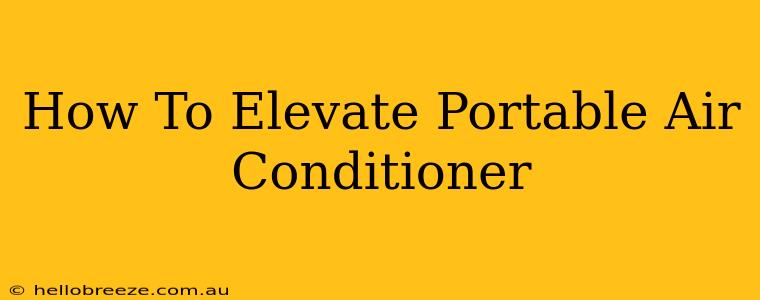Portable air conditioners are a lifesaver on those scorching summer days, offering cool relief without the commitment of a window unit. However, their effectiveness can be significantly hampered by improper placement. Simply plugging it in and hoping for the best won't cut it. To truly maximize your portable AC's cooling power, you need to understand the importance of elevation and how to achieve it correctly. This guide will walk you through the best practices for elevating your portable air conditioner and troubleshooting common issues.
Why Elevation Matters
Portable AC units work by drawing in hot air, cooling it, and then expelling the warm air back out. This exhaust air needs to be efficiently removed from the room to prevent recirculation and maintain optimal cooling. Elevation plays a critical role in this process.
- Improved Exhaust Efficiency: Positioning the unit higher allows the hot exhaust air to rise more easily, preventing it from being drawn back into the intake. This leads to a significant improvement in cooling efficiency.
- Preventing Backflow: A poorly positioned unit can lead to the hot exhaust air being recirculated back into the room, essentially working against itself. Elevation minimizes this backflow, ensuring your room cools down faster and stays cooler for longer.
- Enhanced Airflow: Raising your portable AC unit allows for better overall airflow within the room. This improved circulation helps to distribute the cool air more effectively.
Effective Ways to Elevate Your Portable Air Conditioner
There are several methods to elevate your portable air conditioner, each with its pros and cons. Choose the method that best suits your needs and space constraints.
1. Using a Sturdy Stand or Platform
This is the most recommended method. A dedicated stand, ideally made for portable air conditioners, offers stability and the optimal height for efficient exhaust. Look for stands with a solid base and sufficient load-bearing capacity. Ensure the stand is level to prevent the unit from wobbling or tipping.
2. Placing it on a Table or Shelf
A sturdy table or shelf provides a simple and readily available solution. However, ensure the table or shelf is strong enough to support the weight of the unit and is stable enough to prevent accidents. Also, consider the height – it should be high enough to allow for efficient exhaust but not so high that it becomes inconvenient.
3. Building a DIY Platform
If you're handy, you can build a custom platform using wood or other suitable materials. This allows for a tailored solution specific to your needs and space. However, ensure your construction is sturdy and stable. Use strong materials and secure all connections properly.
Things to Consider When Elevating Your Portable Air Conditioner
- Stability: The most important factor. A wobbly unit is a hazard and can negatively impact performance.
- Height: Aim for a height that allows for efficient exhaust without obstructing airflow.
- Weight Capacity: Always check the weight capacity of any stand, table, or shelf you use.
- Accessibility: Ensure the unit is easily accessible for maintenance and cleaning.
Troubleshooting Common Issues
Even with proper elevation, you might still encounter issues. Here are some common problems and their solutions:
- Room still isn't cooling down: Check for air leaks around windows and doors. Make sure the exhaust hose is properly connected and not kinked.
- Unit is making unusual noises: Check for obstructions and ensure the unit is level.
- Unit is tripping the breaker: This usually indicates an overload. Ensure your electrical circuit can handle the unit's power draw.
By following these tips and understanding the importance of proper elevation, you can significantly improve the cooling performance of your portable air conditioner and enjoy a comfortable and cool home environment. Remember, a little extra effort in setup can make a big difference in your cooling comfort!

